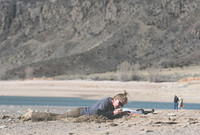Mostly Cloudy, 30° F
Scientists rushed to the Buffalo Bill Reservoir this spring to recover the remains of a Columbian mammoth, but they wound up also finding evidence of four other species from the Ice Age.
Bones …
This item is available in full to subscribers.
The Powell Tribune has expanded its online content. To continue reading, you will need to either log in to your subscriber account, or purchase a subscription.
If you are a current print subscriber, you can set up a free web account by clicking here.
If you already have a web account, but need to reset it, you can do so by clicking here.
If you would like to purchase a subscription click here.
Please log in to continue |
|


Scientists rushed to the Buffalo Bill Reservoir this spring to recover the remains of a Columbian mammoth, but they wound up also finding evidence of four other species from the Ice Age.
Bones and bone fragments found at the bottom of the reservoir west of Cody belonged to a Pleistocene-era horse, bison, camel, and a small artiodactyl creature that’s similar to a deer, the Office of the Wyoming Archaeologist says. They all date back many thousands of years to the Ice Age — a geological epoch which lasted from about 2,588,000 to 11,700 years ago.
The discovery of the additional species was a welcome surprise, said Wyoming State Archaeologist Greg Pierce, whose team just wrapped up the field-study season and will be heading back to the lab to research recent discoveries.
Pierce and others hustled to the Buffalo Bill Reservoir in April after the remains of a mammoth were exposed by low water on the South Fork side of the reservoir, working quickly before water levels rose. It’s been dubbed the Marquette mammoth, named after the small town that was flooded by the creation of the reservoir.
Months after salvaging the remains, scientists are still unsure how long the massive animal rested on the shores of the Shoshone River. Samples of collagen sent to the Accelerator Mass Spectrometry Lab at the University of Arizona for carbon dating tests to determine an approximate age have failed so far, Pierce said. The degradation of the remains sped up as the bones were exposed to water and air, he said.
“We’re just trying to regroup,” Pierce said. “We were really hoping to get a date from the first [test], but not so much.”
There are several options to continue looking for a date, which is important in deciding whether the mammoth died of natural causes, including predation by another animal, or if the mammoth was eaten by humans sometime within the past 14,000 years.
“The problem is you’re paying every time you try to get a date,” Pierce said.
Pierce wants to be sure the next test is likely to turn up positive for a date. The office isn’t rolling in cash and is frugal at every step, he said. The office is charged about $100 for a negative test and about $500 for positive. The Wyoming Society of Professional Archaeologists donated money for the first test.
Cost is not the only problem, either. Carbon dating is a destructive process and you have to destroy part of the bone to send samples for collagen tests. It’s a small part of a bone, but considering archaeologists on the scene meticulously collected minuscule pieces sifted from the sand and dirt around the skeletal remains — small enough to require checking with a microscope — they don’t want to give up any more evidence than is necessary.
“Now we’re going back to the Bureau of Reclamation and figure out the next step,” Pierce said. “We don’t want to throw good money after bad.”
The team would like to have a large piece of femur for the test material, but that part of the mammoth was not found at the site. As a result, they’re limited to the vertebral column, dorsal spines and a couple ribs. It will be at least another two months after sending in the second bone sample before the team would get an estimated date.
“We took [the test sample] from a piece that was relatively thick and in decent shape. We thought we’d be OK,” Pierce said.
There are other options, but each one comes with complications. The team could test the enamel from the Marquette mammoth’s molar, found intact at the site, but those tests can be off by thousands of years. Scientists need to pin down a date of younger than 14,000 years for a chance the site is cultural rather than paleontological — being the remains of a rib dinner rather than a natural death.
Marieka Arksey, collections manager for the University of Wyoming Archaeological Repository, and Pierce are directing a special independent study class at UW this semester. High-level undergrads and graduate students will take the semester to comb through evidence collected. Should the team find evidence of human-influenced mortality — including charred bones or scrapes — the Marquette mammoth site would be one of less than 20 such sites ever discovered; three of those sites have been discovered in Wyoming.
If cultural evidence is found, it’s likely the team will return to the reservoir to dig for more evidence. The site was secured under riprap and scree and is currently many feet under water in the reservoir. The Bureau of Reclamation owns the site, which lies within Buffalo Bill State Park.